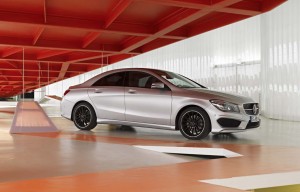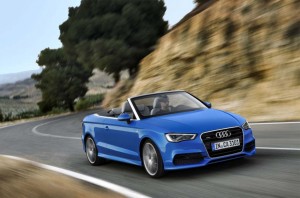
The new 2014 CLA 250 takes Mercedes-Benz into a segment where competitors include Ford's upscale Fusion Titanium editions.
While the all-new 2014 S-Class sedan might serve as the “flagship” of the Mercedes-Benz line-up, the German luxury maker’s big news this coming year is actually its smallest offering, the new CLA.
At first glance, it’s easy to confuse the coupe-like sedan with the older Mercedes CLS model, something that was far from coincidental, company officials concede. But there’s no confusing the numbers on the Munroney window sticker, the compact CLA starting at just $29,990 – compared with the $73,025 base price of the bigger four-door.
With the launch of the CLA, Mercedes is going after a new generation of luxury buyers that it hopes will become long-term brand loyalists. But the German maker isn’t alone. Virtually every manufacturer in the luxury car segment, from BMW to Volvo, is rushing to market downsized and lower-priced luxury models, whether sedan, coupe or crossover. And that could be particularly bad news for mainstream manufacturers like Ford Motor Co. who have themselves been pushing upwards into the luxury segment.
Compact luxury cars are “the next big explosion in the U.S. market,” said Bernie Glaser, marketing chief for Mercedes’ U.S. sales subsidiary, during an interview coinciding with the first media drive of the CLA.
(Click Here to take a first test drive of the 2014 Mercedes-Benz CLA.)
Until now, the German maker had avoided bringing its smallest models, such as the A-Class and B-Class lines to the U.S. And it had little success, a decade ago, with the pint-sized C-Coupe, a two-door spin-off of the C-Class line once known as the Baby Benz.
Indeed, there have been far more failures than success stories in the segment, such as the old Jaguar X-Type. And BMW generated, at best, ho-hum sales with its original 1-Series line. Audi didn’t do much better with the original A3 hatchback.
(First look: Click Here to check out spy shots of the 2015 Lincoln MKC.)
But the times, they are a-changing, as Bob Dylan might say, as those stalwarts of the luxury market, the Baby Boomers, age and a new generation of Millennials begin to covet more exclusive brand offerings.
“Gen-Y make up the next big wave,” Glaser stressed, adding that, “If you want a future, you have to have a Gen-Y strategy.”
Research suggests that Millennials – used to the downsizing of smartphones and other electronic toys – are less likely to measure the value of a luxury car like their parents did: by the pound or inch. They’re also struggling to get good jobs and pay off college loans, so they’re on tighter budgets, which is why Mercedes pushed to deliver the CLA at a base price below $30,000 despite offering the car with a surprising level of standard features and a reasonably swanky interior.
To pull that off, the maker developed a new compact platform it will eventually share with at least five different models, including the CLA, the pint-sized GLA crossover coming to the U.S. for 2014 and new versions of the A- and B-Class. A battery-electric version of the B-Class also will make it to the States.
(Compact crossovers – luxury and mainstream – becoming a major market segment. Click Herefor the full story.)
Mercedes has done a good job recognizing there is “a hole at the bottom of everyone’s line-up,” says Dave Sullivan, senior auto analyst with consulting firm AutoPacific, Inc.
But Mercedes will soon have plenty of company. Audi will launch a new sedan version of the A3 next year developed specifically for the American market. BMW is readying a new 1-series. Jaguar recently revealed off a compact crossover concept, the C-X17, but a sedan sharing the show car’s platform will be first to market in less than two years. Cadillac is gaining momentum with the new ATS sedan – which was named North American Car of the Year last January – and Detroit rival Lincoln will soon launch the MKC compact crossover.
Sullivan expects such models not only to attract traditional luxury buyers, but also “people who might otherwise go into a mainstream vehicle.”
Indeed, there’s been a blurring of the lines in recent years, with luxury makers moving down-market while mainstream manufacturers have moved upscale with offerings like the Ford Fusion Titanium edition which starts at $31,295 and can push into the high-$30,000 range when fully loaded with options.
Not everyone buys the compact luxury strategy, however. Jim Hall, of Detroit-based 2953 Analytics, warns Mercedes is stepping onto “potentially dangerous ground.” The maker, he says, could actually dilute its exclusive image if products like the CLA “become too common.”
But attracting Millennials isn’t the only reason why Mercedes and competitors are entering the new segment. With a fuel-economy rating of 38 mpg on the highway, the CLA is “part of our CAFE (Corporate Average Fuel Economy) and greenhouse gas strategy,” explained marketing chief Glaser.
Meeting the escalating U.S. mileage numbers – which will jump to 54.5 mpg by 2025 – will be a particularly difficult challenge for luxury makers who more traditionally offer heavy, high-power products to buyers who traditionally don’t care as much about prices at the pump.
The higher mileage of cars like the CLA, Cadillac ATS and the BMW 1-Series will make it easier to keep selling traditional luxury models like the all-new Mercedes S-Class.
This story first appeared on NBCNews.com.


As the income divide grows in the US, this is a smart move – and it helps in Europe to fancy-up the low-line cars like the old A-type, putting it a cut above the competition, such as BMW’s 1-series 5-dr mainstay. Makes sense here, too. When I leave my Citroën AX in Italy and get back in my MB here, it’s clear I don’t need that big a car.